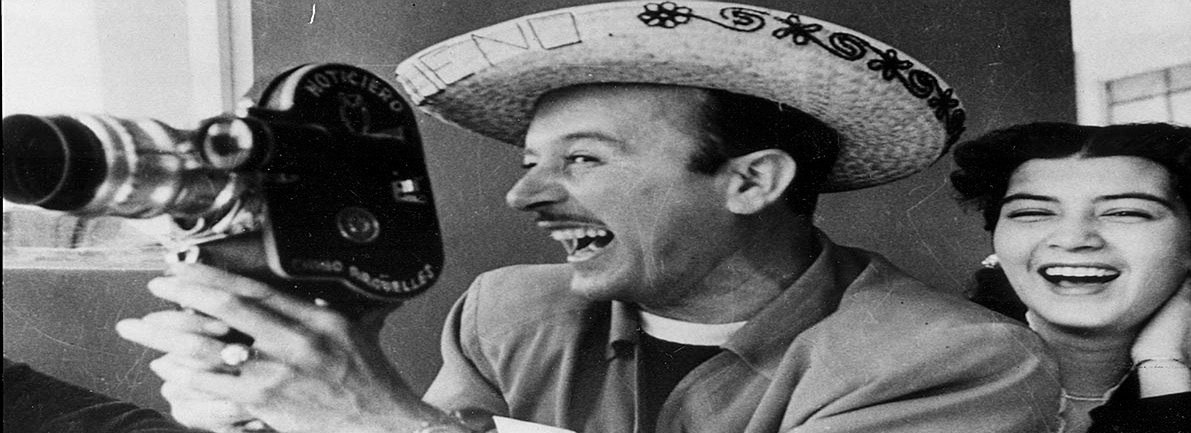- English
- Español

Ranchera, considered the national music of Mexico, has been uniquely influential in shaping other Latin American genres. Mexican singers and their songs have inspired musicians in countries as disparate as Argentina, Colombia and the Dominican Republic. Mexico’s size, and its location between the English and Spanish-speaking Americas have contributed to the country’s role as a hub for Latin American media.
Mexican cinema, which has dominated Latin American screens since the earliest days of film, has been critical in disseminating ranchera throughout the region . Televisa, Mexico’s equivalent to Hollywood, between the 1930s and 1970s, brought the Spanish speaking world movie stars like Cantinflas, Sarah Garcia and Maria Felix. Many of the greatest of these films were musical comedies and dramas, which made singers such as Jorge Negrete and José Alfredo Jimenez into musical icons. Among this galaxy of stars, none in all of Latin America has equaled the fame of Pedro Infante.
Born in 1917 in Mazatlán, Pedro Infante received formal musical training from his father, an upright bassist and music teacher. Infante quickly became proficient with a number of instruments including violin, and guitar, but excelled as a singer, joining his father’s group “La Rabia” at age 16. Many types of Latin American music, including Mexican genres like Norteña, are sung in the throaty style of popular Latin American song inherited from the Iberian Peninsula. The greatest ranchera singers, on the other hand, sing in a more technical style reminiscent of opera and sacred music. Infante’s genius was to combine technical proficiency with an authentic feeling more associated with folk genres.
After his experience with La Rabia and a better known group, orchestra La Estrella de Culiacán, Infante went to Mexico City to make his name as a singer. At first he supported himself as a manual laborer. His early years as a working musician were spent covering songs made famous by other artists like Negrete and Jimenez. His film roles were equally forgettable; until he starred in the 1942 hit, “La feria de las flores”.
Pedro Infante’s acting career is unparalleled in Latin America. The volume of his output alone is remarkable; in barely seventeen years, from “La feria de las flores” until his death in 1957 at age 39, he starred in no less than 59 feature films. Among those films are many of the most famous and best loved movies in Mexican cinema.
Infante’s working class background had a clear influence on his screen persona. The genuine humility with which he portrayed cinematic underdogs was one of the factors that made him beloved by audiences all over Latin America. In films like “Nosotros los pobres”, “Ustedes los ricos” and “Pepe el toro”, he interpreted with profound sympathy the role of the poor and struggling man from the barrio. In contrast, Jorge Negrete, Infante 's greatest on-screen rival, was often cast as proud and imperious. When the two finally faced each other in their classic “Dos tipos de cuidado”, Infante (Pedro Malo) is a happy go lucky carouser, while Negrete (Jorge Bueno) is a humorless aristocrat. Negrete grows more and more indignant as Infante appears to betray him, but in the surprise ending the audience is left to evaluate for themselves who is ‘bueno’ and who is ‘malo.’
Infante’s movies are filled with his music, and many of his most memorable songs appear in his films. His musical duel with Negrete in “Dos tipos de cuidado” is a classic of two virtuoso singers trying to outdo each other. An interpretation in three part harmony of “Cielito Lindo” by Infante, Abel Salazar and Victor Mendoza in “Los tres Garcia” is an equally impressive collaboration. In general, though, Infante sang as a soloist with a traditional mariachi orchestra—trumpet, violin, bajo sexto (a baritone acoustic guitar) and guitarrón (an acoustic bass guitar about the size of a cello). Infante’s persona is just as evident in song as it is on screen, and he is alternately funny, melancholy, and romantic; or, most often, endearingly irreverent.
Regardless of the theme, listeners will note the seemingly effortless mastery of a considerable vocal range. At no time does Infante sound strained or out of his depth, even while interpreting a wide range of styles, from guaracha and bolero to more traditional waltz and the flamencoesque 6/8 style of guapango . Indeed, one of his most important contributions to the ranchera tradition was his inclusion of classic boleros in his repertoire.
Infante was as much of an adventurer in real life as he was on screen. He had a lifelong fascination with flying, and learned to fly his own plane, only to suffer three major accidents in the course of piloting. As a result of the second accident he had a steel plate inserted into his head; and the third accident, on April 15th, 1957, was fatal. His life was cut short but his legend was not diminished. He was laid to rest amid a national day of mourning, serenaded by singers and mariachis. His films remain to this day Sunday afternoon staples of Latin American television.
Reccommended songs
For vocal virtuosity: “La malagueña”, “Cuando se mete la luna”, and the classic “Entre copa y copa”
Funny: “Que tanto es tantito”
Melancholy: “Maria, Maria”
Romantic: “Canta palomita”
Irreverent: “Penjamo”, “Carta a Eufemia”
Add new comment